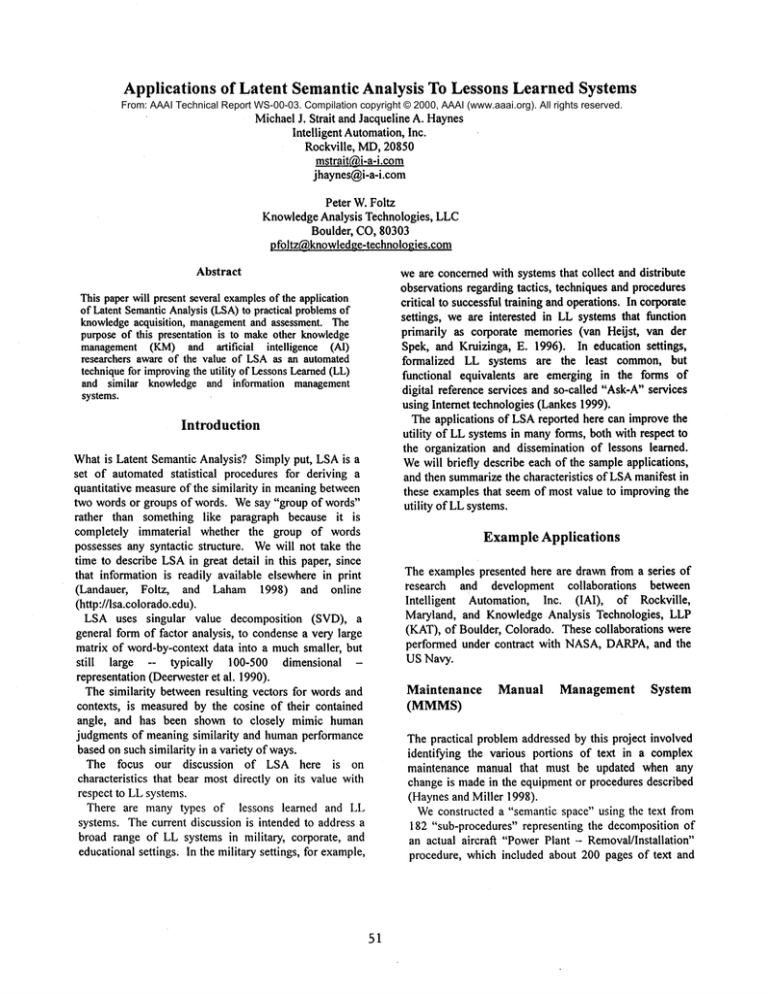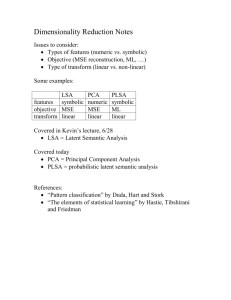
Applications
of Latent Semantic Analysis To Lessons Learned Systems
From: AAAI Technical Report WS-00-03. Compilation copyright © 2000, AAAI (www.aaai.org). All rights reserved.
MichaelJ. Strait and Jacqueline A. Haynes
Intelligent Automation,Inc.
Rockville, MD,20850
mstrait@i-a-i.com
jhaynes@i-a-i.com
Peter W.Foltz
KnowledgeAnalysis Technologies, LLC
Boulder, CO, 80303
p foltz@knowledge-technologies.com
Abstract
Thispaperwill presentseveral examplesof the application
of Latent SemanticAnalysis(LSA)to practical problems
knowledgeacquisition, management
and assessment. The
purposeof this presentation is to makeother knowledge
management(KM)and artificial
intelligence (AI)
researchers awareof the value of LSAas an automated
techniquefor improvingthe utility of LessonsLearned(LL)
and similar knowledgeand information management
systems.
Introduction
Whatis Latent Semantic Analysis? Simplyput, LSAis a
set of automated statistical procedures for deriving a
quantitative measureof the similarity in meaningbetween
two words or groups of words. Wesay "group of words"
rather than something like paragraph because it is
completely immaterial whether the group of words
possesses any syntactic structure. Wewill not take the
time to describe LSAin great detail in this paper, since
that information is readily available elsewhere in print
(Landauer, Foltz, and Laham 1998) and online
(http://lsa.colorado.edu).
LSAuses singular value decomposition (SVD),
general form of factor analysis, to condensea very large
matrix of word-by-context data into a muchsmaller, but
still large -- typically 100-500 dimensional representation (Deerwesteret al. 1990).
The similarity betweenresulting vectors for words and
contexts, is measuredby the cosine of their contained
angle, and has been shown to closely mimic human
judgments of meaningsimilarity and humanperformance
basedon such similarity in a variety of ways.
The focus our discussion
of LSA here is on
characteristics that bear most directly on its value with
respect to LLsystems.
There are many types of lessons learned and LL
systems. The current discussion is intended to address a
broad range of LL systems in military, corporate, and
educationalsettings. In the military settings, for example,
51
we are concernedwith systems that collect and distribute
observations regarding tactics, techniques and procedures
critical to successful training and operations. In corporate
settings, we are interested in LLsystems that function
primarily as corporate memories(van Heijst, van der
Spek, and Kruizinga, E. 1996). In education settings,
formalized LL systems are the least common, but
functional equivalents are emerging in the forms of
digital reference services and so-called "Ask-A"services
using Internet technologies (Lankes1999).
The applications of LSAreported here can improvethe
utility of LLsystems in manyforms, both with respect to
the organization and dissemination of lessons learned.
Wewill briefly describe each of the sampleapplications,
and then summarizethe characteristics of LSAmanifest in
these examplesthat seem of most value to improving the
utility of LLsystems.
ExampleApplications
The examples presented here are drawn from a series of
research and development collaborations
between
Intelligent Automation, Inc. (IAI), of Rockville,
Maryland, and KnowledgeAnalysis Technologies, LLP
(KAT),of Boulder, Colorado. These collaborations were
performed under contract with NASA,DARPA,and the
US Navy.
Maintenance
(MMMS)
Manual
Management
System
The practical problemaddressed by this project involved
identifying the various portions of text in a complex
maintenance manual that must be updated when any
change is madein the equipmentor procedures described
(Haynesand Miller 1998).
Weconstructed a "semantic space" using the text from
182 "sub-procedures" representing the decompositionof
an actual aircraft "PowerPlant - Removal/Installation"
procedure, which included about 200 pages of text and
figures. The decomposition was accomplished by
segmenting the Power Plant - Removal/Installation
procedure using a small number of fully automated
grammatical principles, similar to decomposinga novel
into its constituent paragraphs. Each sub-procedure
ranged in size from several words to several hundred
words. LSAis typically trained on muchlarger bodies of
text, hut in this case we wantedto demonstratethat the
limited lexicon of engine maintenance would promote
positive results, and serve as proof-of-concept,of using a
relatively small corpus.
This project demonstrated two previously untested
capabilities
of LSAthat are important for future
applications to Lessons Learned systems. In the past,
LSAhas been shownto work well as a search aid when
applied to a large corpus of non-procedural (i.e.,
declarative) natural language text.
Maintenance
proceduresdiffer from standard LSAtraining data in that
the set Of words and grammatical constructions used in
procedures is more restricted
than in unbounded
declarative text. Maintenanceprocedures also contain a
large number of figures and diagrams that cannot be
directly evaluated by LSAtechniques.
Our results demonstrated that LSAworkedjust as well
with proceduraltext as it does with declarative text, and
that we were able to successfully search out relevant
figures muchlike text, by including a figure’s labels,
caption and other pieces of text as its own "subprocedure"in our corpus.
LSAagain proved its superiority over simple keyword
matching, meaning that queries returned relevant
matching results in many cases where there were no
commonterms between the query and the result. For
example,the general query "protective caps" was used to
find a variety of procedures concerned with the
installation of protective caps. However, using our
sample semantic space, none of the 14th-20th best
matching sub-procedures mentionprotective caps at all,
but are related to themin that they refer to items that you
wouldput protective caps on (such as fuel lines).
E-mail Filtering
System
The primary goal of this project was to establish the
feasibility of using LSAto filter electronic mail messages
and sort theminto an appropriate set of folders, acting as
an administrative assistant that separates topical mail
fromnoise (Strait 1999).
Weinvestigated the relative effectiveness of filtering
using a semantic space comprised exclusively of email
messages and one comprised exclusively of documents
covering topics of interest (but including no email
messagetext).
52
Weconstructed the email-only semantic space from the
text messages from the Reagan-era National Security
Council, that were made public under the Freedom of
Information Act, and subsequently published in a book
entitled White House E-Mail. The few hundred messages
published in the book were supplemented with
approximately 1,000 additional messages from the same
source obtained from the National Security Archive. We
then constructed a second, more generic space, from
approximately1,200 abstracts of scientific and technical
documentsconcerningnational security and related topics
found at the Defense Technical Information Center web
site (http ://www.dtic.mil/stinet/).
Giventhese two semanticspaces, we tested their ability
to filter sample messagesfrom the published White House
E-mail corpus. Our expectation was that filtering based
upon the NSCe-mail corpus wouldbe more accurate, but
we were most interested in determining the relative
performanceof the two semantic spaces, since this would
allow us to gaugethe applicability of a general-purpose,
and potentially eustomizablespace.
As we expected, the email-specific semantic space was
muchmore effective in categorizing test messagesfrom
the same source, while the general purpose semantic
space performedjust a little better than chance. Looking
at the DTICdocuments, we concluded that there just
wasn’t enoughoverlap of the critical terms betweenthe
DTICcorpus and the. e-mail messagesto achieve better
results. Becauseof this, the computedsimilarity between
messages was not always based on the terms that were
likely most important for categorizing the messages(such
as namesand particular events within the WhiteHouse.)
This finding raises the important point that while LSA
can find and measure similarity of meaning without
requiring the same words to be present in the compared
texts, the words one wants to be able to comparemust
occur somewhere
in the large corpus of text used to create
the semanticspace. [This is artificial intelligence, but not
magic!] Nevertheless, we believe the results were
sufficiently different from chance to indicate the
feasibility
of using the DTICabstracts for a more
generalized corpus.
Team Readiness
Assessment Program (TRAP)
The objective of the TRAPproject was to develop a
technical frameworkto link NavyMission Essential Tasks
(NMTLs)to tactical training curricula for assessing
training effectiveness (Strait and Haynes1999). TRAP
was proposed as an assessment tool that could be used to
measurethe effectiveness of training for both individuals
and teams. TRAPwill use LSAto measure similarities
betweentextual descriptions of what is to be learned and
textual descriptions of trainees’ performancein training
exercises.
The first challenge howeverwas that no training tool
exists today that links doctrine, tasks, conditions, and
outcomemeasuresfound in the Universal NavyTask Lists
(UNTLS)with tactics, techniques and procedures (TTP)
for training use. TRAPwas proposed to provide that
critical missing performanceand training effectiveness
assessment methodological frameworkand capability for
both individual and team training. A great deal of TTP
information exists in the form of Lessons Learned data.
Wehave proposed that LSAbe used not only to assess
training performanceand the effectiveness of training, but
also to help construct NavyMissionEssential Task Lists
(NMETLs)and devise training scenarios based
Lessons Learned.
Wewere not able to work directly with data from the
Navy’s Lessons Learned Database, be we were able to
demonstrate howLSAcould be used to develop a model
of team knowledgerequirements contained in the Surface
Ship Firefighting Manual, a basic componentof Damage
Control training. Surface Ship Firefighting is part of the
DamageControl Task training area specified in Naval
Tactical Task List (NTTL)2.0. The textual representation
of the domainwas the full text of NavalShips’ Technical
Manual (NSTM)555, Volume
The manual was broken up into separate sections
representing individual componentsof knowledgethat a
team memberwouldneed in order to perform firefighting
tasks. Based on this representation
of knowledge
requirements, we demonstrated howwe can use measures
of individuals’ knowledgeto provide an assessment of
the extent to whicha team of individuals have the right
combination of knowledgerequired to perform the team
task. Wesimulated the knowledgeof trainees and the
knowledge required by the team, and showed how LSA
can be used to compute the similarity of a trainee’s
knowledgeto that required by the task and howwell that
trainee’s knowledgewill add to the team’s knowledgefor
successful task completion.
This demonstratedcapability can easily be extended to
search and include relevant knowledgefrom LL systems
in development of NMETLsand for purposes of
individual and team training assessment based on
NMETLs.
Adult Literacy
Tutor (LADDER)
Last but not least, IAI and KAThave recently received an
SBIRPhase 2 award from the Navy (ONR,specifically)
to build a reading comprehensiontutoring system that
relies upon LSAfor multiple functions in lesson
construction, assessment of student progress, and
53
automated guidance through lesson content (Haynes and
Strait 1999).
The tutoring system, called LADDER,builds on
knowledgeof the characteristics of adult learners and
acquisition of literacy skills by using LSAto deliver
reading passages selected to matchrelevant aspects of a
reader’s skills and knowledge. LADDERuses an
instructional approach based on scaffolding, whichmoves
readers up a ’Reading Ladder’ in a step-wise fashion,
based on an individual’s growingcapability in reading
specific text. The steps of the ladder relate to levels of
complexityin the structure and content of the text, so that
readers graduallyincrease the difficulty of text they read
as they continueinteracting with the tutor.
Animportant feature of LADDER
is that scaffolding is
accomplishedby using the individual reader’s knowledge
of the subject area before and after reading each passage
to identify the next passageto be read, andto assess the
reader’s comprehension of text throughout the
instructional process.
In our Phase 2 research, IAI and KATwill be exploring
automated procedures for using LSAto identify Lessons
Learneddata available online that augmentstext-based
reading material and incorporate it during the authoring
process to enhance the learning experience and add
motivation and interest for the student. This workis in
progress.
Summary
The text componentsof Lessons Learned Systems are of
indeterminate size, form, function and content. The
characteristic of lessons learned most common
across all
examplesis that it is a reported observation. Becausethe
data they contain is often highly situational, the language
used is frequently informal and cursory. Even though
some LL systems may be more formal, there are no
widely applied standards of form and content
The example applications described above show that
LSAis capable of addressing someof the most difficult
challenges of accessing, evaluating, and utilizing
knowledgeacross multiple LLsystems.
Applications of Latent Semantic Analysis as
exemplified above and in related research showpromise
as automated techniques for improving the utility of
Lessons Learned (LL) and similar knowledge and
information managementsystems.
References
Landauer,T. K., Foltz, P., and Laham,D. 1998. An
Introduction to Latent SemanticAnalysis. Discourse
Processes, 25:259-284.





